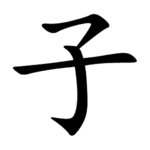Radical 39
Radical 39 meaning "child" or "seed" is 1 of 31 Kangxi radicals (214 radicals total) composed of three strokes.
| 子 | ||
|---|---|---|
| ||
| 子 (U+5B50) "child, seed" | ||
| Pinyin: | zǐ | |
| Bopomofo: | ㄗˇ | |
| Gwoyeu Romatzyh: | tzyy | |
| Wade–Giles: | tzŭ3 | |
| Cantonese Yale: | jí | |
| Jyutping: | zi2 | |
| Pe̍h-ōe-jī: | chú | |
| Kana: | シ, こ shi, ko | |
| Kanji: | 子偏 kohen | |
| Hangul: | 아들, 알 · adeul, ssi | |
| Sino-Korean: | 자 ja | |
| Stroke order animation | ||
 | ||
In the Kangxi Dictionary, there are 83 characters (out of 49,030) to be found under this radical.
In Chinese astrology, 子 represents the first Earthly Branch and corresponds to the Rat in the Chinese zodiac.
Characters with Radical 39
 Oracle bone script character
Oracle bone script character Bronze script character
Bronze script character Great seal script character
Great seal script character Small seal script character
Small seal script character
| strokes | character |
|---|---|
| without additional strokes | 子 孑 孒 孓 |
| 1 additional stroke | 孔 |
| 2 additional strokes | 孕 |
| 3 additional strokes | 孖 字 存 孙 |
| 4 additional strokes | 孚 孛 孜 孝 孞 斈 |
| 5 additional strokes | 孟 孠 孡 孢 季 孤 孥 学 孧 |
| 6 additional strokes | 孨 孩 孪 |
| 7 additional strokes | 孫 孬 孭 |
| 8 additional strokes | 孮 孯 孰 孲 |
| 9 additional strokes | 孱 |
| 10 additional strokes | 孳 孴 孶 |
| 11 additional strokes | 孵 孷 |
| 13 additional strokes | 學 孹 |
| 14 additional strokes | 孺 孻 |
| 16 additional strokes | 孼 |
| 17 additional strokes | 孽 孾 |
| 19 additional strokes | 孿 |
Literature
- Fazzioli, Edoardo (1987). Chinese calligraphy : from pictograph to ideogram : the history of 214 essential Chinese/Japanese characters. calligraphy by Rebecca Hon Ko. New York, 1987: Abbeville Press. ISBN 0-89659-774-1.CS1 maint: location (link)
- Lunde, Ken (Jan 5, 2009). "Appendix J: Japanese Character Sets" (PDF). CJKV Information Processing: Chinese, Japanese, Korean & Vietnamese Computing (Second ed.). Sebastopol, Calif.: O'Reilly Media. ISBN 978-0-596-51447-1.
gollark: For example, a train station I'm aware of has a ticket office with 4 people at desks and basically no activity, even though they mostly just act as bad frontends for the automatic ticket system, for which there are also (not very good) automatic ticket machines.
gollark: There are some things which I think probably should be automated but aren't, though, and I think that's mostly just because some people want there to be humans around for whatever reason and pressure to "preserve jobs".
gollark: Oops, I said knowledge work twice.
gollark: In some cases it's probably possible but it would have drawbacks or isn't cost-effective yet.
gollark: Examples of hard to automate things: social interaction, anything where people are expected to be able to deal with weird unexpected situations and handle them properly, knowledge work things, anything where you need lots of mobility, complex knowledge work.
This article is issued from Wikipedia. The text is licensed under Creative Commons - Attribution - Sharealike. Additional terms may apply for the media files.